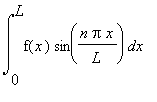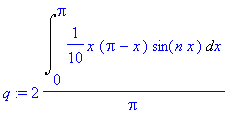 , as shown in Figure 24.8 (below), and released, it oscillates. We solve for the motion of the string at any time
, as shown in Figure 24.8 (below), and released, it oscillates. We solve for the motion of the string at any time
Example 24.3
A string of length
![]() has its ends fixed at
has its ends fixed at
![]() , and
, and
![]() on an
x
-axis. The string is under tension, so that when it is given the initial shape
on an
x
-axis. The string is under tension, so that when it is given the initial shape
 , as shown in Figure 24.8 (below), and released, it oscillates. We solve for the motion of the string at any time
, as shown in Figure 24.8 (below), and released, it oscillates. We solve for the motion of the string at any time
![]() .
.
The associated BVP that models the motion of this string is
 = c^2*u[xx](x,t)](images/plucked_string162.gif) , t > 0
, t > 0
![]()
![]()
![]() =
=

![]()
The solution, given by
![u(x,t) = Sum(b[n]*sin(n*Pi*x/L)*cos(c*n*Pi*t/L),n =...](images/plucked_string168.gif)
and
![b[n] = 2/L](images/plucked_string169.gif)

is implemented in Maple as follows. The initial shape function is
> f := x*(Pi-x)/10;
![]()
>
and Figure 24.8 (which shows its graph) is
> plot(f,x=0..Pi,color=black, scaling=constrained, xtickmarks=3, ytickmarks=2, labels=[x,u], labelfont=[TIMES,ITALIC,12]);
![[Maple Plot]](images/plucked_string172.gif)
>
The Fourier coefficients are given by the integral
> q := (2/Pi)*Int(f*sin(n*x),x=0..Pi);

>
whose value is
> b := simplify(value(q));

>
A peek at the first ten coefficients
> seq(subs(n=k,b),k=1..10);
![]()
>
reveals that the odd-indexed terms "survive," the even-indexed terms are zero. Moreover, the coefficients rapidly converge to zero for this function. In fact, they go to zero as
![]() , a rapid decrease, as the following conversion to floating point numbers shows.
, a rapid decrease, as the following conversion to floating point numbers shows.
> seq(evalf(subs(n=k,b)),k=1..10);
![]()
![]()
>
Hence, a very few terms will be needed to get a good approximation to
![]() . We can test this by examining how many terms it takes to get the Fourier series of
. We can test this by examining how many terms it takes to get the Fourier series of
![]() to approximate
to approximate
![]() well. The first two distinct partial sums in the Fourier series for
well. The first two distinct partial sums in the Fourier series for
![]() are
are
>
p1 := sum(b*sin(n*x),n=1..1);
p3 := sum(b*sin(n*x),n=1..3);
![]()

>
with
![]() (thin black) and
(thin black) and
![]() (thick red) shown in Figure 24.9, below.
(thick red) shown in Figure 24.9, below.
> plot([f,p1],x=0..Pi,color=[black,red], thickness=[1,3], scaling=constrained, xtickmarks=3, ytickmarks=2, labels=[x,u], labelfont=[TIMES,ITALIC,12]);
![[Maple Plot]](images/plucked_string187.gif)
>
This experiment suggests that two terms of the series for
![]() might yield a reasonably good approximation, so write
might yield a reasonably good approximation, so write
![U = sum(b[n]*sin(n*x)*cos(c*n*t),n = 1 .. 3)](images/plucked_string189.gif) =
=

![]()
that is,
> U := sum(b*sin(n*x)*cos(c*n*t),n=1..3);

>
as an approximation to the solution. Set
![]() , that is,
, that is,
> U1 := subs(c=1,U);

>
to obtain the graph of the solution surface seen in Figure 24.10, below.
> plot3d(U1, x=0..Pi, t=0..4*Pi, axes=frame, labels=[x,`t `,`u `], labelfont=[TIMES,ITALIC,12], style=hidden, color=red, tickmarks=[3,6,3], orientation=[-45,60]);
![[Maple Plot]](images/plucked_string195.gif)
>
The plane sections
![]() are snapshots in time, freezing the physical motion of the string for each value of
are snapshots in time, freezing the physical motion of the string for each value of
![]() . Exhibiting these shapshots in succession forms a movie, or animation, of the physical motion of the string. This animation is given by the following Maple command.
. Exhibiting these shapshots in succession forms a movie, or animation, of the physical motion of the string. This animation is given by the following Maple command.
> animate(U1,x=0..Pi,t=0..2*Pi, frames=60, color=black, scaling=constrained, xtickmarks=3, ytickmarks=2, labels=[x,`u `], labelfont=[TIMES,ITALIC,12]);
![[Maple Plot]](images/plucked_string198.gif)
>
As the string moves in space-time, its history generates a surface, a small part of which we now animate.
>
>
F := z -> plot3d(U1, x=0..Pi, t=0..z):
display3d([seq(F(Pi/10*k),k=1..30)],insequence=true, axes=boxed, labels=[x,t,u], labelfont=[TIMES,ITALIC,12], style=hidden, color=red, tickmarks=[3,5,3]);
![[Maple Plot]](images/plucked_string199.gif)
>